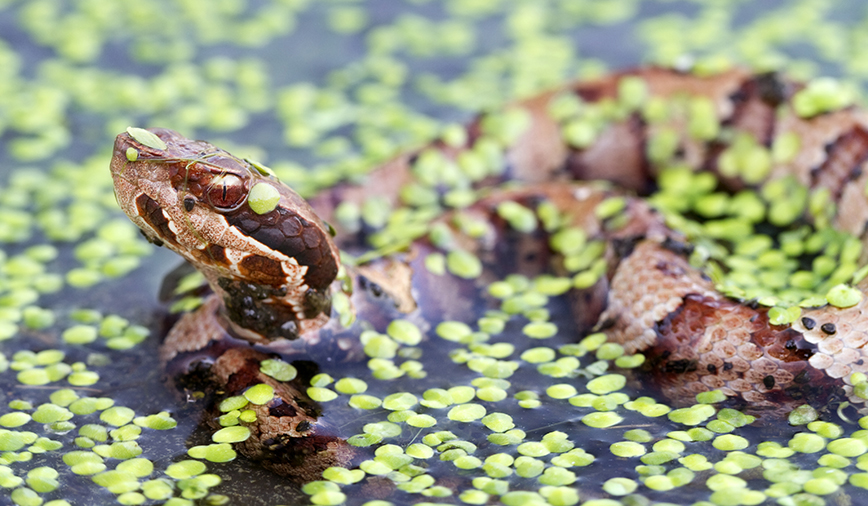I got an email the other day from my friend Scott, a great guy and recent graduate of our Kane County Certified Naturalist program. In it he detailed a trip to Starved Rock State Park and, best of all, included pictures of his adventure.
I suppose some might say, though, that they were pictures only a naturalist could love. Scott, you see, saw no fewer than 11 northern water snakes as he walked a river trail between Owl Canyon and Beehive Overlook. Eleven!
Before you recoil in horror, or cringe in disgust (I know some of you already have!) take a minute to consider these fascinating creatures. The northern water snake, Nerodia sipedon, is among the most common snakes seen in and along waterways throughout Illinois, including our own Fox River. Its distinctive brown bands and blotches immediately distinguish it from another common area snake, the garter, but also cause it a fair share of trouble. Many people, noting the snake’s thick body and aquatic nature, immediately assume it to be a venomous cottonmouth. And, falling back on the old adage that “the only good snake is a dead snake,” they quickly dispatch the unfortunate critter, usually with a shovel or rock to the head.
But really, cottonmouths (a.k.a. water moccasins) live only in extreme southern Illinois and, for the record, shouldn’t be killed either. Northern water snakes, in contrast, can be found statewide. They favor habitats with a water source, typically streams and ponds, and frequently can be found basking on rocks or logs or foraging in the water for their favorite foods—fish and frogs.
Fishermen sometimes slander this snake, protesting that it reduces fish populations. But this belief, too, is inaccurate. Healthy gamefish are too large, fast and strong for a water snake to capture. Instead, this snake feasts on sick and weak individuals, a habit that actually improves the health of fish populations.
Water snakes have a few other habits that have not endeared them to the general public: If harassed, they bite. Repeatedly. They release a strong musk. Effortlessly. They void feces. Copiously. And, if disturbed just after a meal, they often regurgitate. And that’s just icky.
But if you leave them alone, they’ll return the favor. On sunny warm days, they can be found basking on rocks and vegetation near water (what a coincidence—so can I) and often pose nicely for photographs. Just ask Scott!
Check out these other fun water snake facts:
It’s Greek to me: Nerodia is derived from the Greek words neros meaning “flowing” or “liquid” and dia meaning “through.” Sipedon is derived from the Greek word sepedon which means “a serpent whose bite causes mortification.”
Bands and blotches: Young northern water snakes are identified by a unique set of markings. The brown bands at the snake’s neck become blotches along the back. Underneath, the snake’s belly is light colored and usually is flecked with red or brown half-moon shaped spots.
But just as humans change with age, so do snakes. Northern water snakes darken as they get older and may appear solid brown or even black when dry. (Faint markings may be visible when the snake is wet.)
Ovo-what? Northern water snakes breed in spring (April/May) and give birth in late summer (August/ September). They are ovoviviparous, meaning that newborns emerge from the female encased in a thin membrane. They quickly break through and begin life as independent yet miniature versions of their parents. Parental care ends with birth; the young go one way, mom heads the other.
As you venture out along the Fox and its tributaries this summer, keep an eye open for the northern water snake. Admire it for its graceful beauty. Appreciate the role it plays in our local ecology. And above all, look, but don’t touch!
Pam Otto is the manager of nature programs and interpretive services for the St. Charles Park District. She can be reached at potto@stcparks.org or 630-513-4346.

